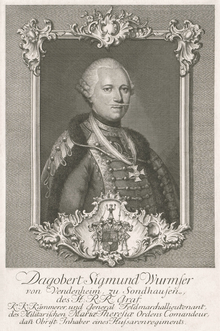Dagobert Sigmund von Wurmser
Count Dagobert Sigmund von Wurmser , also Dagobert Siegmund von Wurmser (born May 7, 1724 in Strasbourg , † August 22, 1797 in Vienna ) was an Austrian field marshal .
Life
Wurmser began in 1741 his military career in the French service, took in 1742 at the incident Belleisles in Bohemia part and distinguished himself in the Seven Years' War , then came into Austrian services over and was 1763 to major general in 1773 to head one, Hussars and some years later to Lieutenant promoted .
In the War of the Bavarian Succession he commanded an advanced corps that attacked the Prussians at Habelschwerdt on January 18, 1779 and took many prisoners, including Major General Adolf von Hessen-Philippsthal .
Soon after the Peace of Teschen , Wurmser was promoted to commanding general in Galicia and in 1787 to general of the cavalry . At the outbreak of the French Revolutionary War (coalition wars) he was given supreme command of the Austrian army on the Upper Rhine in spring 1793 . He commanded victorious battles near Rohrbach (June 29), Germersheim (July 5) and Essingen (July 27) and thereby thwarted the attempts of the French to break through to Mainz as a relief force . He then drove them out of the Bienwald (August 23) and on October 13, supported by Karl Wilhelm Ferdinand, Duke of Braunschweig , conquered the Lauterburg and Weissenburg lines . After several disadvantageous skirmishes and the lost Second Battle of Weissenburg , he felt compelled to go back across the Rhine with a severely weakened army at the end of December. He was recalled in January 1794.
In August 1795 he again took over the command of the army on the Upper Rhine and defeated the French on October 18 before Mannheim . His troops captured this fortress on November 22nd.
At the end of June 1796 he was entrusted as field marshal, in Beaulieu's place, with the supreme command of the army in Italy . After fighting from July 29th to August 12th, he forced the French to lift the siege of Mantua . However, after a series of unfortunate skirmishes - the battle of Castiglione is noteworthy here - he had to retreat with the remains of his army to the fortress (September 13th), which was now blocked again. Although he skilfully defended the square, the impossibility of relief and the lack of food and medicine compelled him to surrender on February 2, 1797 after a siege of nine months. Napoleon Bonaparte granted him and his troops the most honorable conditions when the fortress was handed over.
Wurmser was to receive the general command in Hungary , but died before taking up this post.
family
He married on January 25, 1761 in Vendenheim Sophia Henrietta Rosina Juliana von und zu der Thann († June 27, 1772). Five days later he was elevated to the rank of count. The couple had several children:
- Henrietta Theresia (1763–1763)
- Henriette Dorothea (April 8, 1767 - December 1, 1827) ∞ Karl Heinrich Johann Wilhelm von Schlitz called von Görtz (November 2, 1752 - December 10, 1826)
- Christian (1768-1844)
Wurmser was a member of the Prague Masonic Lodge Truth and Unity on the Three Crowned Pillars.
reception
During his lifetime, his abilities were judged to be rather low by those around him : Josef Wenzel Graf Radetzky , who served as Rittmeister under Wurmser from 1795, characterized him as a "decayed old man, deaf, old and unwilling".
By the imperial resolution of Franz Joseph I. from 28 February 1863 Wurmser was in the list of "most famous, to the everlasting emulation worthy warlords and generals of Austria" added to their honor and memory of a life-size statue in the Feldherrenhalle the then newly constructed kk Hofwaffenmuseums (today: Army History Museum Vienna ) was built. The statue was created from Carrara marble by the sculptor Angelo Malgrati in 1867 and was dedicated by Emperor Franz Joseph himself.
In 1894, Wurmsergasse in Vienna's Rudolfsheim-Fünfhaus (15th district) was named after him.
literature
- Oscar Criste: Wurmser, Dagobert Sigmund Graf von . In: Allgemeine Deutsche Biographie (ADB). Volume 44, Duncker & Humblot, Leipzig 1898, pp. 338-340.
- Constantin von Wurzbach : Wurmser, Dagobert Siegmund Graf . In: Biographisches Lexikon des Kaiserthums Oesterreich . 59th part. Kaiserlich-Königliche Hof- und Staatsdruckerei, Vienna 1890, pp. 1–7 ( digitized version ).
- Alfred von Vivenot : Thugut , Clerfait and Wurmser: Original documents from the KK House, Court and State Archives and the KK War Archives in Vienna from July 1794 to February 1797 . Vienna 1869. GoogleBooks
Individual evidence
- ↑ Dagobert Sigismond Wurmser family tree at geneanet.org
- ↑ Schlitz family tree called von Görtz
- ^ Ludwig Lewis: History of Freemasonry in Austria and Hungary . Vollrath, Leipzig 1872, p. 20 f.
- ^ Helmut Neuhold: Austria's war heroes. Soldiers, warriors, generals. Ares Verlag, Graz 2012 ISBN 978-3-902475-99-2 p. 197
- ^ Johann Christoph Allmayer-Beck : The Army History Museum Vienna. The museum and its representative rooms . Kiesel Verlag, Salzburg 1981, ISBN 3-7023-0113-5 , p. 35
| personal data | |
|---|---|
| SURNAME | Wurmser, Dagobert Sigmund von |
| ALTERNATIVE NAMES | Wurmser, Dagobert Siegmund von |
| BRIEF DESCRIPTION | Austrian field marshal |
| BIRTH DATE | May 7, 1724 |
| PLACE OF BIRTH | Strasbourg , Alsace |
| DATE OF DEATH | August 22, 1797 |
| PLACE OF DEATH | Vienna |
